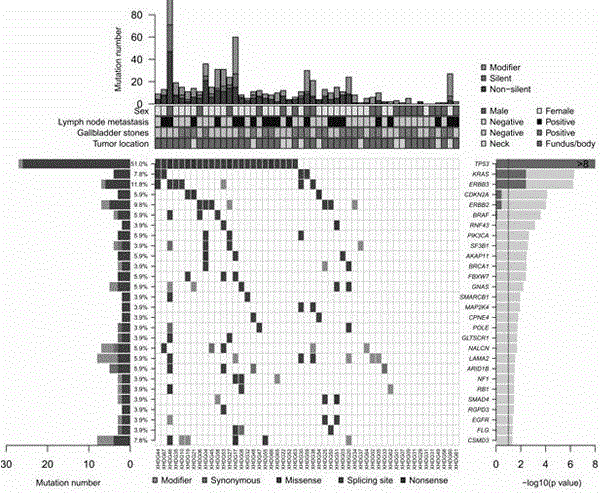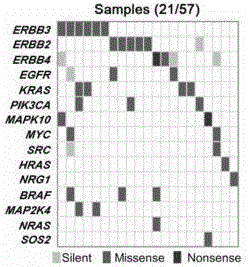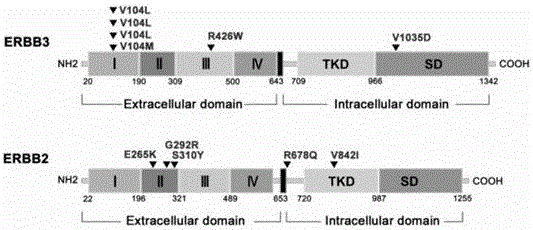Targeted sequencing method for mutations in erbb signaling pathway for prognostic assessment of gallbladder cancer
A technology for targeted sequencing, gallbladder cancer, applied in the field of molecular biology
- Summary
- Abstract
- Description
- Claims
- Application Information
AI Technical Summary
Problems solved by technology
Method used
Image
Examples
Embodiment 1
[0030] Example 1 Targeted sequencing method for ERBB signaling pathway mutations
[0031] 1. Collect tumor tissue samples from the subject.
[0032] 2. Genomic DNA extraction
[0033] Thaw the tissue block, take an appropriate amount of tissue, wash it in PBS solution, put it into a centrifuge tube (1.5ml) filled with 500µl PBS, cut it into pieces with scissors; centrifuge at 12000rpm for 8min, remove and discard the supernatant. Gallbladder cancer cells were first processed into cell suspension, then centrifuged at 10,000 rpm for 1 min, the supernatant was poured out, 200 µl of buffer GA was added, and shaken until completely suspended.
[0034] Add 0.45ml TES and mix well, then add 50μl SDS (10%), 20μl proteinase K (20mg / ml), mix well, keep warm at 56°C for 4-6h, shake once every 2h, until the system is clear.
[0035] Place it at room temperature, add an equal volume of saturated phenol (500µl), turn it up and down gently for 5min, centrifuge at 12000r / m for 10min, separa...
Embodiment 2
[0049] Example 2 ERBB signaling pathway gene mutation can be used as an independent prognostic factor for gallbladder cancer
[0050] 1. Experimental method
[0051] Our research group used the genome-wide exome technology as described in Example 1 to perform targeted sequencing on 57 pairs of gallbladder cancer paired tissues to obtain the frequency of gene mutations, and then conduct pathway analysis for high-frequency mutation genes through the KEGG database, and then according to the patient Gender, age, degree of differentiation of gallbladder cancer, TNM stage, lymphatic metastasis, nerve invasion, lesion location, presence or absence of jaundice, condition of resection margin, ERBB signaling pathway gene mutation, and presence or absence of gallbladder stones were grouped, and the ERBB signal among the groups was compared. Pathway gene mutations.
[0052] SPSS 18.0 was used for data analysis, and count data were analyzed by χ 2 Test (Fisher's exact probability method ...
Embodiment 3
[0069] Example 3 Clinical application of ERBB signaling pathway gene mutation as an independent prognostic factor for gallbladder cancer
[0070] The method described in Example 1 was used to predict the prognosis of a patient with gallbladder cancer, and it was found that the ERBB3 gene of this subject had a mutation, and the mutation site was V104L, suggesting that the prognosis of this patient with gallbladder cancer was poor. According to statistics, the actual survival period of the patient was 7.5 months.
PUM
 Login to View More
Login to View More Abstract
Description
Claims
Application Information
 Login to View More
Login to View More - R&D
- Intellectual Property
- Life Sciences
- Materials
- Tech Scout
- Unparalleled Data Quality
- Higher Quality Content
- 60% Fewer Hallucinations
Browse by: Latest US Patents, China's latest patents, Technical Efficacy Thesaurus, Application Domain, Technology Topic, Popular Technical Reports.
© 2025 PatSnap. All rights reserved.Legal|Privacy policy|Modern Slavery Act Transparency Statement|Sitemap|About US| Contact US: help@patsnap.com



